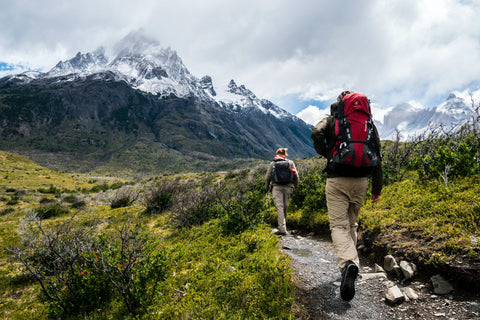However, when more people take to the trails, the pressure on mother nature increases and we see the mountain roads thickening with traffic.
The question we should all ask ourselves are; how can we become more eco-conscious and sustainable hikers in 2021 and beyond?
To answer this question, we have compiled a list of 5 things you can easily adapt to be a more sustainable and conscious hiker.
Choose your routes carefully
Over tourism has become a problem for cities and sights around the world. We see this happening in the national parks and other “instagrammable locations” as well.
When planning a hike, choose your routes carefully and wisely. Don’t go hiking the places that are most prominent on social media or where you know “everyone hikes”.
Think about alternatives where there will be less traffic both in terms of cars, and on the trails themselves.
As a word of warning; stick to a pre-existing path to avoid trespassing privately owned land or protected local habitats.
If you are a beginner hiker, make sure you read up on the basics, such as The Ten Hiking Essentials.

Leave no trace
This is a big one and probably the simplest and easiest to implement. Unfortunately frequently ignored.
The principle is very simple to follow: leave no trace on the trail you’re wandering.
Leaving trash such as paper or plastic is awful for the local ecosystem. Wildlife can mistake it for food, or get trapped in things like cans or plastic ropes
Our Rowdybars are perfect companions for your next hiking trip. Just make sure you follow this principle and bring the packaging back with you and dispose of it responsibly.
No matter how small, always bring it back out, including cigarette butts.

Wear sustainable clothing
The choices you make in your clothing affect the environment. Instead of using fast fashion, research sustainable or ethical outdoor clothing brands. Well-made clothing and gear last longer, which means fewer things will end up in landfills.
You want to keep your eyes open for sustainable certification such as Bluesign or Fair Wear.
Brands that are focused on sustainability are Kathmandu, Merrell, Patagonia, and more.
PS
You don’t always have to buy new outdoor gear and clothing when taking up hiking. Quality hiking gear can be bought second-hand on places like eBay, Gumtree, and Facebook Marketplace. Buying second-hand will not only save you money, but it will also lower your carbon footprint considerably.

Carefully consider where you set up camp
If you are going thru-hiking or multi-day hiking, you want to be mindful of where you are setting up camp in order to leave minimal footprints and impact on the environment.
Everyone wants that perfect spot overlooking the mountains or the beautiful lake with the perfect sunrise. However, not all places are suitable for setting up camp when considering the local flora and its wildlife.
Camp responsibly and sustainable and keep these things in mind when setting up camp:
- Don’t move or damage vegetation to set up your tent.
- Pick sturdy trees for hammocks.
- Try to pick camping spots with naturally cleared flooring.
- If there is a previously used campsite on your way, consider using the same patch and firepit.
- Try to avoid lighting a campfire altogether, especially when extra dry conditions (and double-check that it is even allowed). Burning down a forest or a mountain is not cool (and obviously extremely dangerous).
Poop responsibly
As odd as this point sounds, hiking and finding human excrements and toilet papers with that unmistakable brown line, is NOT cool!
And not only is it uncool, but it can be very bad for the environment too!
Some hardcore hikers take the leave no trace principle to the extreme and will bring everything with them back, including their poop.
Actually, some parks or areas do in fact require that you leave absolutely nothing behind.
In these cases, there are biodegradable odor-neutralizing bags that can be stuffed in portable poop tubes. Yes, that totally is a thing!
However, when nature inevitably calls, you should still be focused on where you do your business.
Never go pee pee or poo poo closer than 200 feet to a stream or a river to avoid contaminating natural water sources.
And as a courtesy for the other hikes, do the business away from the trail.
And if you do go no 2, the best practice is to dig a hole in the ground, do what you have to do, and cover it afterward.
Bonus points for bringing recycled and ethical toilet paper!
And there you have it. Five things you can easily implement into your hiking routine to be more sustainable and eco-friendly in 2021.
Happy trails!

